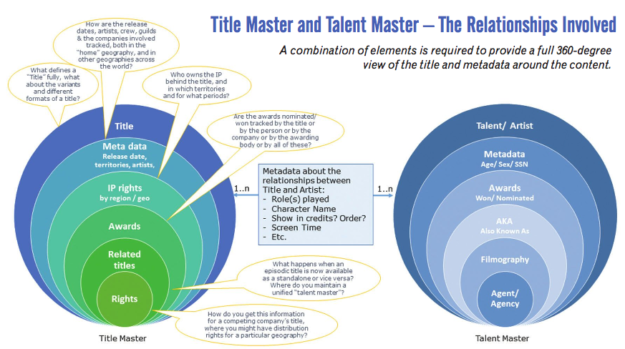Exclusives

M&E Journal: Decoding the Intricate Web of Related Title Master Data
Story Highlights
By Nimish Gupta, Director Product Management, Riversand Technologies
Digital is the main reason just over half the companies on the Fortune 500 have disappeared since the year 2000! Luckily, the M&E industry has been at the forefront of the move to digital.
A majority of millennials are consuming premium media on the go, on all their connected devices. Consumers see no significant divide between digital and traditional media: what they want is more flexibility, freedom and convenience in when and how they consume their preferred content. The digital and consume anywhere trends imply the need for rich information about the titles on offer. This information includes the title itself, plus “metadata” like plot summaries, ratings, cast and crew, extending to a number of other metadata elements like awards, genres, related movies etc. IMDB has become a standard public go-to source for both title and metadata information.
Additionally, most content producers have their own internal equivalents, and broadcasters also provide title and metadata information in their content directories. Industry bodies like EIDR help with the standardization of title information and the unique identification of information across media houses. Advertisers and broadcasters use AD-ID to uniquely identify advertising assets.
These standards help identify content and advertisements, but don’t do much to bring rich information about the content. Within a typical M&E enterprise, things can be surprisingly murky. Media asset identification systems have necessarily existed for decades and have often “evolved” through a series of patches and quick fixes.
All internal IT systems need a way to uniquely reference titles (either released, or still in development), and unfortunately often end up using different or non-standard identifiers. Over time such internal systems tend to proliferate, with each arising to deal with a specific set of issues.
As a result, there is considerable variation between systems in terms of how titles are categorized, which metadata is associated with each title, and the very definition of a title or metadata. The information about the content should be gathered as early as possible, preferably at the time of the content creation.
The information should conform to the data quality standards defined by the organization, and it should be possible to have different standards for different classes of information (for instance a TV episode might not require the same depth of metadata as a feature). The system needs to ensure it measures the quality of the metadata and applies the right data governance and stewardship to guide users along the way of creating/publishing title and metadata information.

Some of the complexities with mastering title and metadata information for the M&E domain come from the incredibly diverse, unique and often incestuous relationships that exist. What defines a “title” fully, what about the variants and different formats of a title?
Who owns the IP behind the title, and in which territories and for what periods? How are the release dates, artists, crew, guilds and the companies involved tracked, both in the “home” geography, and in other geographies across the world? Are the awards nominated or won tracked by the title or by the person or by the company or by the awarding body or by all of these? What happens when an episodic title is now available as a standalone or vice versa? Where do you maintain a unified “talent master”? How do you get this information for a competing company’s title, where you might have distribution rights for a particular geography? How do you model compilations, mini-series, associations, split and combines, and maintain consistency of information from the title to these?
It’s a combination of all these elements (and more) that provides a full 360-degree view of the title and metadata around the content. Clearly it’s not one person or team who can pull this information together.
It requires massive collaboration across the organization, and more often than not, with partner organizations participating as well. These requirements for centralized title and metadata management are best met through a solution that understands and has successfully modeled different M&E scenarios in a true multi-domain way, managing multiple related master data domains.
A centralized system might also be attempted as another internal home grown system, but will likely end up as being a part of the IT sprawl due to the complexities involved.
Some key requirements for a title and metadata master data management solution for M&E are:
* Collaborate internally and externally to create and enrich title and metadata information.
* Define data governance rules that are universally applicable and variants for different formats/ markets.
* Stewardship to ensure the defined governance rules are adhered to.
* Real time integration with a slew of internal and external systems to ensure a single title master.
* Identify and eliminate duplicates, merge data across sources.
* Manage through quantifying data quality of information.
* Build and manage the mesh of relationships between the titles and other entities like artists, crew, companies, awards, ratings and rating. agencies, regions, rights, genres etc.
* Link titles to trends and social media conversations on those titles.
Centrally identifying and managing master data through the data life cycle opens up different additional avenues of monetization through data areas you may not have previously focused on. The challenge then becomes changing the processes to capture such information here on, and retrofitting the new content on the existing title master in an efficient, cost effective and operationally viable manner.
New insights can be constantly gained from social media trends around the titles. Dealing with such large volumes, velocity and variety of data is a core strength of any big data stack. But when one adds the “veracity” of data to the mix, the need turns to master data management tools coupled with big data capabilities. The complexities of the relationships involved in the M&E industry are beyond the capabilities of conventional solutions and require new age solutions as well.
Ultimately these should be standard capabilities of the chosen master data management platform.
Click here to translate this article
Click here to download the complete .PDF version of this article
Click here to download the entire Spring 2016 M&E Journal









